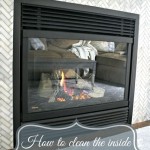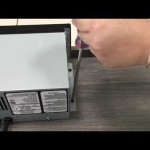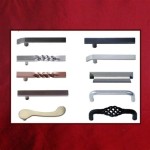Mantle and TV Fireplace Heat Shield: Protecting Your Electronics and Home Aesthetics
The convergence of entertainment technology and traditional home heating elements presents unique challenges. Modern living spaces often feature a television mounted above a fireplace, a design choice that maximizes space and creates a focal point. However, the heat generated by a fireplace, whether gas, electric, or wood-burning, can pose a significant threat to the longevity and functionality of a television. Protecting the television and other susceptible materials, like a wooden mantel, requires a proactive approach, primarily through the use of a fireplace heat shield.
A fireplace heat shield acts as a barrier, deflecting radiant heat away from the television and the mantel. Without a properly installed and effective heat shield, the prolonged exposure to high temperatures can damage the sensitive electronic components within the television, leading to picture distortion, premature failure, and even fire hazards. Similarly, a mantel can warp, crack, or even ignite if it is not adequately protected from the direct heat of the fireplace. Understanding the principles of heat transfer and the specific risks associated with fireplace heat is crucial for selecting and implementing the appropriate heat shielding solution.
Understanding Heat Transfer and Fireplace Risks
Heat transfer occurs through three primary mechanisms: conduction, convection, and radiation. Conduction involves the transfer of heat through direct contact between objects. Convection is the transfer of heat through the movement of fluids (in this case, air). Radiation is the transfer of heat through electromagnetic waves, which do not require a medium to travel. Fireplaces primarily emit heat through radiation, which travels in all directions from the firebox.
The radiant heat emitted by a fireplace can directly impact the temperature of the mantel and the television. The intensity of the heat is dependent on several factors, including the type of fireplace, the size of the fire, and the distance between the fireplace and the objects above it. Gas fireplaces, while often perceived as cleaner and more controlled, can still generate significant radiant heat. Wood-burning fireplaces, known for their higher heat output, pose the greatest risk. Electric fireplaces, although generally cooler, still generate some heat that can contribute to potential damage over time if not managed properly.
The materials used in the construction of mantels and televisions are susceptible to degradation from prolonged heat exposure. Wood, commonly used for mantels, can dry out, crack, and warp under high heat conditions. Certain types of wood are more resistant to heat than others, but all wood will eventually be affected by continuous exposure. Televisions, being electronic devices, contain sensitive components that are designed to operate within a specific temperature range. Exceeding this range can lead to malfunctions, reduced lifespan, and permanent damage. The plastic casings of televisions can also soften, deform, or even melt under excessive heat.
Furthermore, the potential for fire hazards should not be overlooked. While the risk of a television spontaneously combusting due to fireplace heat is relatively low, the risk of a mantel igniting is more significant, particularly with wood-burning fireplaces. The accumulation of dust and debris around the fireplace and mantel area further increases the risk of ignition. Regular cleaning and maintenance, combined with a proper heat shield, are essential for mitigating these risks.
Types of Fireplace Heat Shields
Fireplace heat shields are available in various designs and materials, each offering different levels of protection and aesthetic appeal. The selection of the appropriate heat shield depends on the type of fireplace, the size of the mantel, the distance to the television, and the overall design of the room. Common types of fireplace heat shields include mantel shields, television shields, and combination shields that protect both the mantel and the television.
Mantel shields are typically installed directly onto the underside of the mantel, deflecting heat upwards and away from the mantel surface. They are often made of metal, such as steel or aluminum, and may be coated with a heat-resistant paint or powder coating. Some mantel shields are designed to be discreet, blending seamlessly with the mantel's existing design. Others are more decorative, adding a visual element to the fireplace area. The effectiveness of a mantel shield depends on its size, shape, and the material it is made from. A larger shield will generally provide more comprehensive protection than a smaller one.
Television shields are designed specifically to protect the television from fireplace heat. These shields are typically mounted above the fireplace, creating a barrier that blocks the radiant heat from reaching the television screen and components. Television shields often incorporate ventilation features to allow for the dissipation of heat that may accumulate behind the shield. They are available in various sizes and styles to accommodate different television models and mounting configurations. Some television shields also offer adjustable features, allowing for fine-tuning of the shield's position to optimize heat deflection.
Combination shields offer both mantel and television protection in a single unit. These shields are typically larger and more complex in design than individual mantel or television shields. They are often custom-made to fit specific fireplace and mantel configurations. Combination shields can provide a more comprehensive solution for heat protection, ensuring that both the mantel and the television are adequately shielded from the effects of fireplace heat. The aesthetic integration of these shields is crucial so that they do not overwhelm the design of the fireplace and surrounding room.
When selecting a fireplace heat shield, it is important to consider the material of construction. Metal shields are generally more effective at blocking radiant heat than shields made of other materials. Steel and aluminum are common choices for metal shields, offering a good balance of heat resistance, durability, and affordability. The thickness of the metal also plays a role in its effectiveness. Thicker metal shields will provide better heat protection than thinner ones. Coatings, such as heat-resistant paint or powder coating, can further enhance the shield's heat resistance and durability.
Installation and Maintenance of Fireplace Heat Shields
Proper installation of a fireplace heat shield is crucial for its effectiveness. Incorrectly installed shields may not provide adequate protection, leaving the mantel and television vulnerable to heat damage. The installation process typically involves attaching the shield to the mantel or the wall above the fireplace using screws, brackets, or other mounting hardware. It is important to follow the manufacturer's instructions carefully to ensure that the shield is installed correctly and securely.
Before installing a heat shield, it is essential to assess the existing conditions of the fireplace and mantel. Check for any signs of damage, such as cracks, warping, or discoloration. Repair any existing damage before installing the heat shield. Measure the dimensions of the mantel and the space above the fireplace to ensure that the shield is the appropriate size. Consider the viewing angle of the television and ensure that the shield does not obstruct the view. Consult with a professional if you are unsure about any aspect of the installation process.
The installation process may vary depending on the type of heat shield and the specific fireplace configuration. For mantel shields, the shield is typically attached to the underside of the mantel using screws or brackets. Ensure that the screws are long enough to securely penetrate the mantel but not so long that they protrude through the top surface. For television shields, the shield is typically mounted to the wall above the fireplace using wall anchors or studs. Ensure that the wall anchors or studs are strong enough to support the weight of the shield and the television. For combination shields, the installation process may involve a combination of mantel and wall mounting techniques.
Once the heat shield is installed, it is important to maintain it properly to ensure its continued effectiveness. Regularly inspect the shield for any signs of damage, such as dents, scratches, or corrosion. Clean the shield periodically to remove dust, dirt, and soot. Use a mild detergent and a soft cloth to clean the shield. Avoid using abrasive cleaners or scouring pads, as these can damage the shield's surface. Check the mounting hardware periodically to ensure that it is still secure. Tighten any loose screws or bolts. Replace any damaged or worn-out components.
In addition to maintaining the heat shield, it is also important to maintain the fireplace itself. Regularly clean the firebox to remove ash and creosote. Inspect the chimney for any signs of blockage or damage. Ensure that the fireplace damper is functioning properly. Have the fireplace professionally inspected and cleaned annually. Regular maintenance of the fireplace will not only help to prevent fire hazards but also improve the efficiency of the fireplace and reduce the amount of heat that is emitted.

Mantleflect Shield Above Fireplace Ideas Outdoor Remodel Tv

Any Of Mantle Heat Shield Hearth Com Forums Home Fireplace Mantels Remodel

5 Ways To Protect Your Tv From The Heat Of Fireplace Tips

5 Ways To Protect Your Tv From The Heat Of Fireplace Wall Living Room Decor Over

Fireplace Hoods Heat Deflectors Custom

5 Ways To Protect Your Tv From The Heat Of Fireplace Tips

Heatshield Mantleflect 5 Inch X 47 Set Of 2 Rolls

Coolsmart Heat Vent No Need For A Mantle To Shield Tv
Heat Shields Hearth Com Forums Home

Heatshield Mantleflect 5 Inch X 47
Related Posts








